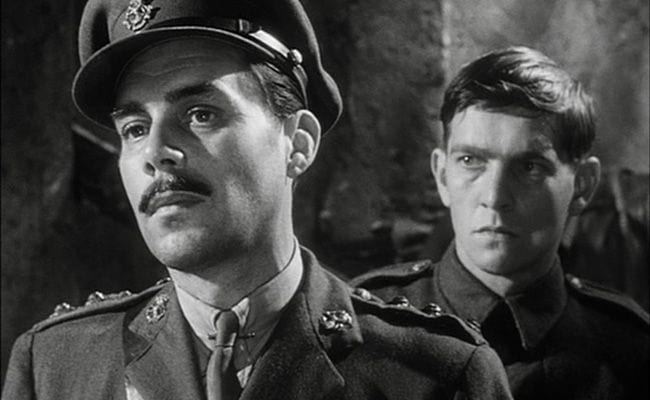
Joseph Losey never saw a cornice, plinth, or pediment he didn’t like. This most architectural of directors opens King and Country with a slow, caressing shot that runs over two minutes long, moving around the details of a war memorial from arch to statuary to frieze. We hear only traffic, and then we cut to newsreel footage of an explosion with a boom. Surely, only Losey would open a movie this way.
Then we get to the credits, scored by Larry Adler’s lonely harmonica as the close-up camera roves over mud, boots, and duckboards of the trenches of WWI. The explosion repeats again, followed photos from the Imperial War Museum, then capped off by a transition of one startling skull-headed soldier’s corpse to the head of Tom Courtenay, lying down (already dead without knowing it) and supposedly playing that harmonica we’ve been hearing. We also hear a few lines from A.E. Housman. In this way, the film announces itself as serious art.
Courtenay plays an English private, the only survivor of his original group, who one day at Passchendaele decided to take a walk home to England and got pretty far before being arrested as a deserter. (Could this be a germ of inspiration for Tim O’Brien’s novel Going After Cacciato, about a Vietnam soldier who decides to walk to Paris?) Dirk Bogarde plays the officer who serves as his counsel in the court-martial which comprises the bulk of the drama. He suggests that the soldier might be suffering from shellshock, a diagnosis emphatically rejected by the doctor (Leo McKern).
Nobody in the private’s company, from his buddies to his commanding officer to the prosecuting counsel, really want him to be convicted and shot, but they all fear the machinery through which by merely doing their duty, they sentence the private to being shot. Since he would be unlikely to last much longer in combat anyway, he’s doomed by the nature of his world.
Scripted by Evan Jones (who later wrote the terrific Australian film Wake in Fright) from John Wilson’s play and James Lansdale Hodson’s novel Return to the Wood, Losey’s film does an excellent job of “opening out” the theatrical piece while remaining tense and claustrophobic. The actors are excellent, and they’re abetted by a production crew doing conspicuously outstanding work.
Much credit goes to editor Reginald Mills, who handles the cuts and dissolves to photos and a few imagined fragments to help break the theatricality, to which we return by other devices like the soldier’s staccato choruses. Denys Coop’s camera, shooting in high-contrast black and white, moves smoothly around the glum and oppressive sets designed by Richard Macdonald. Losey’s films love a gliding camera, and here he sometimes adopts a godlike view of the action, looking down upon the behavior of men scrambling like rats (who are also literally present) or going through rituals.
Everything about the film is so well done, it’s curious that it lacks the power of the earlier Paths of Glory or the later Breaker Morant, two other downbeat court-martial dramas. Its strongest dramatic sparks are in the brief appearance by third-billed McKern. In those moments, we’re suddenly plunged into the story more than observing a bit of cinema.
Otherwise, Losey’s considered approach turns it into a fussy, intellectualized affair, but this over-consideration is consistent throughout his output. This characteristic is also rather pleasing for those of us who look for signs of the auteur touch. Film after film, Losey seems to regard the human animal with dispassionate curiosity as his camera analyzes the space around his benighted souls.


![Call for Papers: All Things Reconsidered [MUSIC] May-August 2024](https://www.popmatters.com/wp-content/uploads/2024/04/all-things-reconsidered-call-music-may-2024-720x380.jpg)



